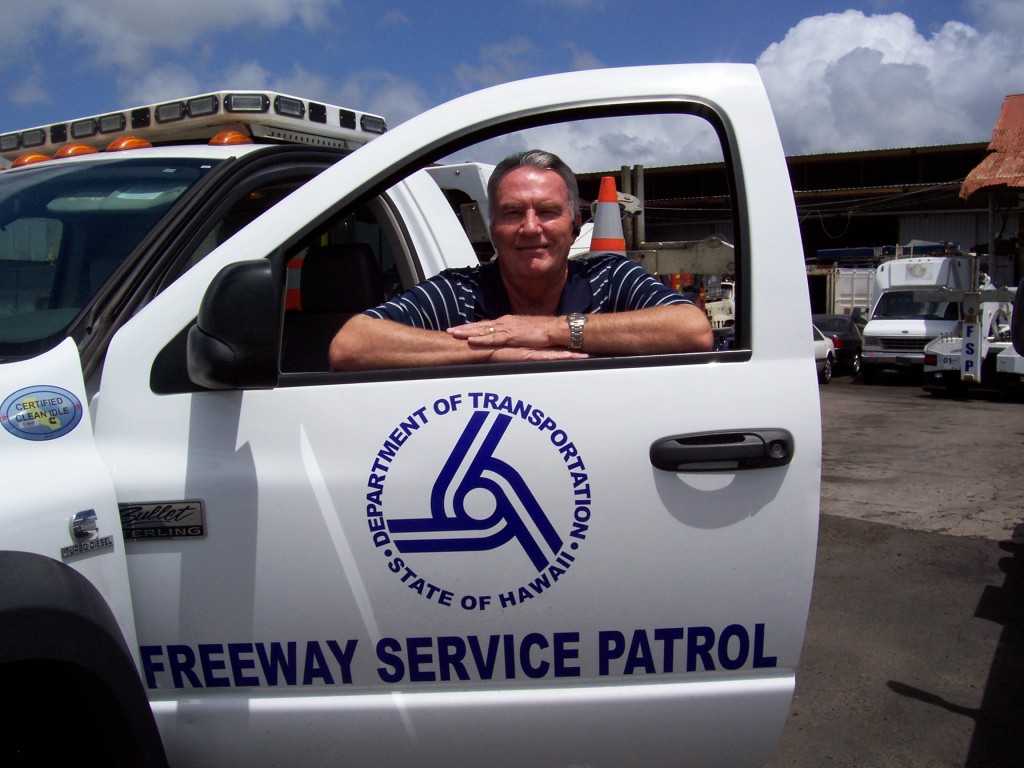Profile: Harvey L. Heaton
Name: Harvey L. Heaton
Company: Telvent Farradyne, Inc., based in Rockville, MD
Department: ITS/Traffic Incident Management
Position/Title: Project Manager, Hawaii Freeway Service Patrol (FSP) Project
What gave rise to the launch of the FSP in Hawaii this past June? Hawaii Department of Transportation (HDOT) began planning for implementing an FSP program a number of years ago. Interest in FSP is based on cost-benefits realized by other areas, reduction in congestion, safety improvements and the reduction in secondary crashes.
What is the source of the “pilot” funds and how long will the pilot last?
HDOT secured a Federal funding of $3.51 million and the state of Hawaii contributed $390,000 for the two-year demonstration project.
What are the criteria for evaluating the pilot? Who is tasked with the evaluation?
A consultant for HDOT will use a performance measures model designed by UC Berkeley’s Partners for Advance Transit and Highway (PATH) to evaluate the FSP program. PATH worked with California DOT (Caltrans) to create this model for determining the benefit to cost ratios for specific FSP routes. The California statewide FSP average Benefit to Cost ratio is about 8 to 1.
In developing the FSP program, what different business models did you consider?
The Hawaii FSP program is largely based upon the California FSP model. This model has proven very successful for rapid detection and quick clearance of freeway incidents.
This model requires the FSP trucks to continually roam the designated FSP freeway routes. More than 80% of stranded motorists and traffic collisions are located within the zero to 10 minute range of occurrence.
The Hawaii FSP program uses conventional light/medium duty tow trucks for this project. The tow trucks were designed & built to provide low maintenance long-term service for four years or more. Each truck accrues an average monthly mileage of about 5,900 miles and patrol approximately 36 miles of Honolulu freeways.
The project’s Standard Operating Procedures (SOP) manual was developed from a blend of the best practices/policies and procedures used in FSP programs in California, Florida and Northern Virginia.
Who is Telvent Farradyne? What is their role and how did they become involved with the Freeway Service Patrol?
Telvent Farradyne, Inc. designs, develops, implements, operates, and maintains intelligent transportation systems, solutions for public and private sectors in North America. It offers software products and services related to traffic management, travel information, public transportation, and electronic toll collection systems.
Telvent was awarded the turn-key contract for the Hawaii FSP project. The company has other traffic incident management projects throughout the country.
Telvent’s personnel have a rich history with Traffic Incident Management (TIM), including FSP. They have experience with different facets of TIM throughout the country.
Hawaii is a unique state in so many ways. Is there anything that is especially unique or distinctive about the nature of the HFSP?
The HDOT contract required light bars and arrow boards mounted on the FSP tow trucks. Telvent Farradyne chose a combination light bar and arrow board rather than two distinctive units. These combination units offer superior emergency lighting performance and an effective arrow boards in one compact unit.
In addition, the HDOT contract also required the FSP tow trucks be equipped with a Global Positioning Satellite system to track the movements of the trucks. Telvent Farradyne chose the Track Star® GPS system manufactured by Transportation Information Systems, Inc. These GPS units provide “real time” information, i.e., FSP tow truck direction, speed and position. Our FSP dispatcher monitors the movements of the tow trucks and redirects the FSP tow trucks to ensure even freeway coverage and selecting the closest truck(s) for motorist assists and accidents.
The traffic data from motorist assists and accidents are being collected using PDAs and our FSP dispatcher log.
This GPS system is currently being enhanced to also collect data that includes time of incident and lat/long locations every time the arrow boards are activated. Once this new system is up and running we will discontinue using the PDAs and coordinate all data collected using the GPS system and our FSP dispatcher log.
How has your previous work at the California Highway Patrol (CHP) as the FSP manager influenced the Hawaii FSP Pilot program?
My previous 31-year work experience with the CHP has been invaluable with setting up and managing the Hawaii FSP project. My first 16 years with CHP was spent as a field officer and sergeant. I thought I knew a lot about Traffic Incident Management (TIM). However, it wasn’t until I took over the statewide FSP program in California that I realized TIM was much more complex than my previous field experience had taught me.
My last ten years of my CHP career was spent managing the statewide FSP program. (California’s 13 regional FSP programs daily deploy about 350 tow trucks.) In this capacity I worked alongside Caltrans, regional transportation management agencies, first responder management groups and the California towing industry. I learned a great deal about many of the internal institutional barriers and political issues these groups face. This knowledge helped me to better understand their approach and perceived limitations with participating in and managing their respective TIM roles.
The towing industry is one of the most complex entities to work with and many times overlooked and/or discounted by the general first responder community. In a number of states towing groups have stated that FSP has improved the image of the towing industry. Many times the towing community has been excluded, rather than included in the general TIM planning process. I feel this is a big mistake since towing plays a significant role in most TIM operations.
What do you wish others would, but don’t seem to, understand about highway safety?
The importance of ensuring that all state and local TIM policy makers champion highway safety programs like FSP. In order to sustain successful TIM programs all the players need to be committed to the common goal of initiating progressive traffic safety concepts and not be afraid to try new and different approaches to solving traffic congestion-related problems.
At times some may lose sight of the big picture with TIM. That is, ensuring the safety of all motorists in and around incidents on the freeways. Our true beneficiaries of FSP are all those motorists who are not impeded by traffic-related incidents due to FSP’s quick response and clearance. When this occurs we have done our job correctly.
All too many times the focus is on the primary victims of incidents and not the other motorist (secondary victims) who are also negatively impacted by the initial incidents.
Secondary victims must be a strong consideration in any TIM planning process. In addition to the delay factor, these motorists are also exposed to becoming involved in secondary collisions, which can be more severe than the original traffic incidents.
Progressive states have implemented procedures that take into account the plight of these secondary victims by establishing policies for mitigating incidents quickly. Tow trucks rather than utility pickup trucks expedite removal and relocation of stranded and accident-involved vehicles.
What are the most important qualities and skills required for Hawaii FSP drivers?
Hawaii FSP drivers are the main ingredient for sustaining a successful FSP program. FSP driver applicants that express their desire to help people are an important quality not to be overlooked.
Spending the required time and money to thoroughly interview and train the drivers pays big dividends down the road so to speak.
When FSP drivers come in from their shifts I listen to them explain how they have applied what they have been taught. Also, I take note of their enthusiasm for the job they are performing and watch their dedication grow as each day passes.
What kind of training do the Hawaii FSP drivers receive?
Our minimum hiring age is 25 and all drivers are required to be CDL licensed. My experience has shown that mature drivers are more likely to stay with the program and provide better services to the public.
The first week of our four-week training course is spent in the classroom where they are taught the FSP policies and procedures outlined in our SOP, advance traffic control techniques, safe driving practices, First Aid (including CPR and Automated External Deliberator device), HazMat recognition and basic fire extinguisher use.
Following the classroom training, the FSP driver trainees begin tow truck operations training. They are given a proficiency test at the end of this training period to ensure they are ready to go on the road by themselves.
What would you like other states to know about Hawaii’s FSP?
In our planning and progress meetings with HDOT and briefings with our FSP drivers and dispatchers, we continually discuss the need for flexibility and adaptability when changes are needed to improve service and safety to the public.
HDOT and Telvent Farradyne are committed to providing the best possible FSP program in the country.
The Hawaiian community has fully embraced the Hawaii FSP program. Feedback from our assisted motorist survey cards indicate that many express their sincere appreciation for the FSP services being provided and want the program to remain and even expand. We are currently receiving survey cards with an average of 93% excellent service rating from assisted motorists.
Even though the motoring public experiences many services provided by HDOT, when they are personally assisted and even saved from the perils of being stranded on the freeway, they express how their tax dollars are being used wisely.
What would you like to know about other states’ safety service patrols?
In this severe economic climate, how have the other state’s FSP programs been affected?
If other states’ FSPs have been forced to reduce services, what criteria were used by these other states to continue to provide optimum services?
